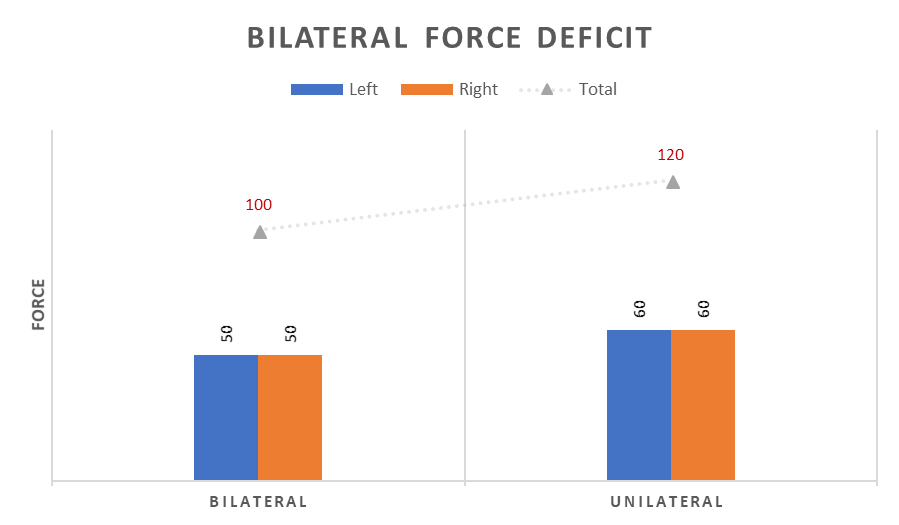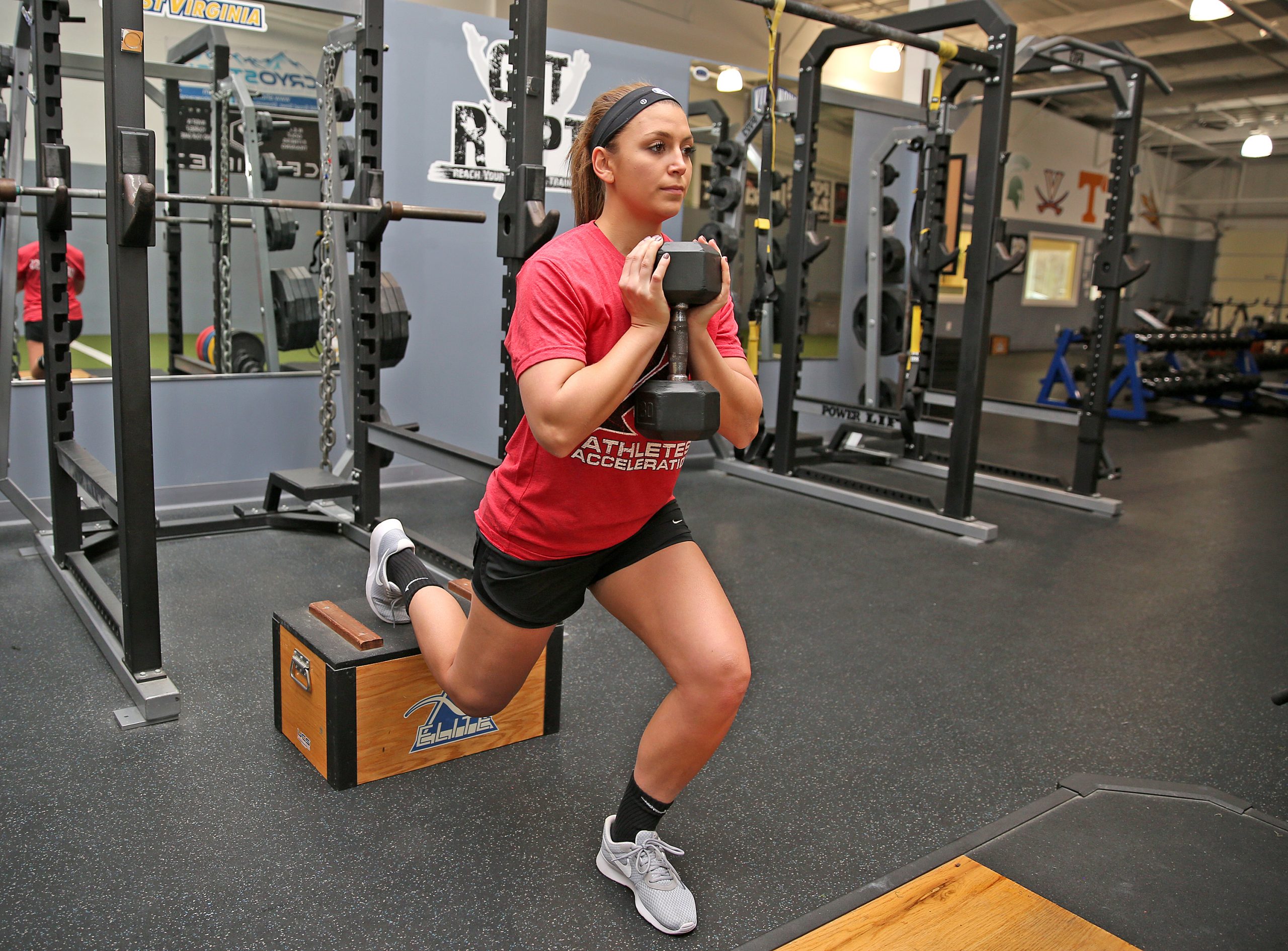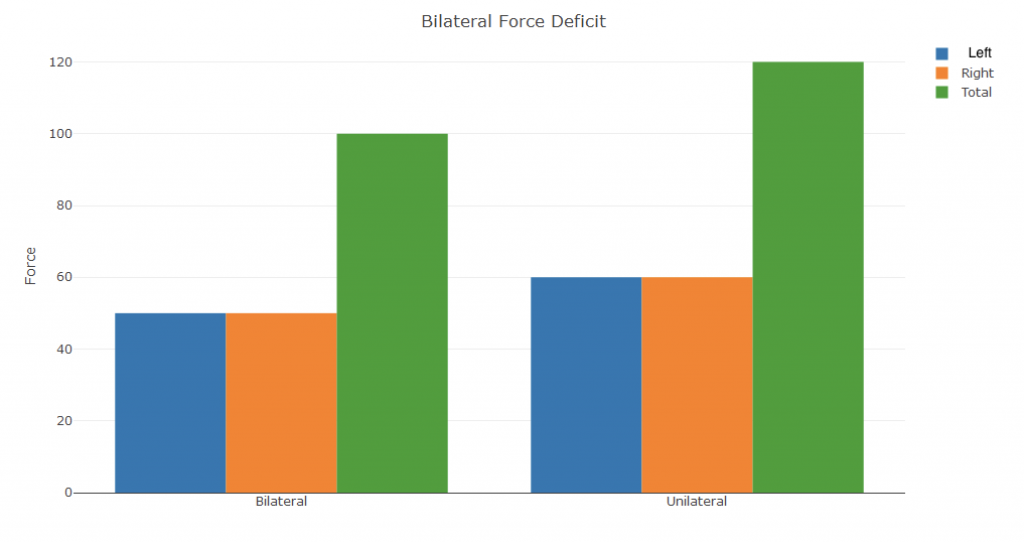When 2 Plus 2 Equals 3
Bilateral Force Deficit and Its Implications on Training
By: Lauren Green
Introduction
As always, I like to come up with my topics from questions I’ve been asked or conversations with colleagues. And one conversation I felt kept coming up frequently was the idea that bilateral and unilateral exercises/training are mutually exclusive; and one can have a perceived superiority to the other. There are training philosophies out there that will base their programing pillars or priorities on the foundation that either unilateral or bilateral training is superior.
I can’t say that I fall into either category, but I do find the comparisons interesting.
“How much impact does the mode of an exercise have on the training stimulus and its resulting adaptation?”
“Is a barbell back squat superior to a barbell Bulgarian split squat? Superior in what way?”…
These questions led me to think more about the training goals, or expected adaptations of training. A mode’s value or superiority is dependent on its ability to impact the desired outcome. Presumably, our resistance training programs are focused on improving athletic qualities such as force production (strength), soft tissue tolerance (resiliency), or rate of force development (power). Therefore, when we compare modes of exercise, we should evaluate how those qualities are effected by the training stimulus.
The idea of comparing bilateral vs unilateral training reminded me of this quote I had heard in the past, and thanks to modern conveniences (Google) I was able to find the person who said it:
“The whole is greater than the sum of its parts.” – Aristotle
This quote represents the idea that when all attributes are working in synchronicity, their production will have greater value than each of the individual attributes’ values combined. This is a really profound thought because it reaches to the core of behavior in social animals. We want to believe that there is power in unity. So it’s understandable to follow this thought process when trying to predict a response to a training stimulus.
Having a “global” influence should have more carry over than “local” adaptations. That is what we presume, but is it true throughout all athletic qualities? Research has shown that this does not necessarily apply when looking at muscular force. Thanks to Bilateral Force Deficit (BFD), the sum IS greater than the whole when it comes to us creating force.
What Is Bilateral Force Deficit?
Bilateral Force Deficit is a phenomenon seen during maximum muscular contractions. Bilateral force deficit is described as the occurrence of when the sum of forces exerted by homonymous muscles unilaterally is typically higher than the sum of forces exerted by the same muscles bilaterally (1). For this discussion we will think of this from the perspective of gross motor patterns or exercise movements (note that this does apply to and has been studied in smaller fine motor movements such as bilateral and multi-finger pressing and grip strength) (2) (3).
To give a simple example of this phenomenon, I often use leg extension as an example (see Figure 1). Lets propose that an athlete has a bilateral one rep max (1RM) of 100lbs. We can assume that each of the lower limbs is producing around half of the force being applied. With the occurrence of BFD, we see that each of the limbs can actually produce greater force while working individually.
 Figure 1 – THEORETICAL EXPLANATION OF BILATERAL FORCE DEFICIT WITH LOWER LIMB EXTENSION (SEATED KNEE EXTENSION)
Figure 1 – THEORETICAL EXPLANATION OF BILATERAL FORCE DEFICIT WITH LOWER LIMB EXTENSION (SEATED KNEE EXTENSION)
As you can see in Figure 1, the sum of forces from the unilateral 1RMs is greater than the bilateral total. But how can this be? Logically, we would assume that each legs’ maximum force should be duplicated during bilateral execution. But this does not seem to be the case in many instances. There are a few different theories as to why the phenomenon may occur. One of which is based upon the movement strategies of the athlete during execution (kinematics).
With the example of a back squat, if an athlete has an issue with posture, muscular imbalance, joint dysfunction, or just poor technique; he/she can be limited in their ability to resist a greater overall load. While during the unilateral version (Bulgarian or RFE split squat) the athlete will have less overall load to manage. Thus providing less of a challenge to those limiting factors of pattern execution.
Another theory as to why we see bilateral force deficit is grounded in the neurological and contractile properties of force production (kinetics). Some research suggests that a lower level of neural drive is found during bilateral maximal contractions, as if the engagement of more muscles requires a stronger signal from the central nervous system (4). This has been disputed by a number of studies using electromyography (EMG), that show equal potentiation during bilateral and unilateral testing (5) (1).
While disregarding neural capacity, the next culprit (specifically to gross motor patterns) would be the force-velocity relationship differences between bilateral and unilateral movement patterns (6). Simply put, with the assistance of a second limb, the center of mass is accelerated faster and higher velocities are reached during bilateral movement. This diminishes the time needed to build more force, or even the need to apply more force. With the assistance of a second limb, the reactive force needed from each limb individually is lower.
Possible training implications
Despite not knowing the reason as to why, we know that bilateral force deficit is real. More importantly, we should be asking ourselves of the possible implications on programming knowing that BFD exists. Since BFD is not seen in all individuals, could it possibly be a limiting factor or possibly a performance indicator? Is bilateral force deficit the foundation that supports the ideology that unilateral training is superior to bilateral? Can working unilaterally versus bilaterally decrease total tonnage (volume)? Luckily for us, some really smart people have already started to look into answering these questions for us.
When comparing the effectiveness of an exercise or its mode, we need to identify which specific qualities we are comparing. We might want to know which mode can yield greater strength gains in the targeted muscle groups. We also might wonder if one mode, lets say unilateral, has a cross-over effect and improves the same qualities in the other modes.
What we are really looking for is an understanding of the predictable outcomes that come from us influencing the stressor by implementing either mode of an exercise. Understanding the differences in these modes and their expected impact on adaptation can give us more specificity in our exercise prescription and greater confidence in our programming.
One general implication that comes to mind, in regards to BFD, is its impact on global and local strength. This idea of global versus local strength is similar to the idea of gross and more defined motor patterns. With our squat example from earlier, I know that I can encounter greater overall load (weight) at one time with the bilateral mode than I will during unilateral. Although the sum of those single leg squats will be greater than the back squat, I will only be dealing with a fraction of the bilateral weight at any given time. This means that there is greater acute global work during a given rep during the bilateral mode. This can lead to more muscle groups being engaged throughout the exercise and higher global hormone response.
Although that sounds like a win-win, consider the other side of the coin. A unilateral mode has a greater local effect on strength and thus can have a greater impact on each limb individually. If a player has a strength asymmetry, a bilateral pattern might not be as beneficial. Like always, the athlete’s needs should dictate which mode is a priority.
Another thought I had when reviewing the implications of bilateral force deficit was the idea of overall work being done within training sets, also known as tonnage. Tonnage refers to the total volume of load lifted, which is calculated by multiplying the weights used by the repetitions and then by the sets (weight x reps x sets). From a work capacity perspective, can one mode be greater than the other?
According to a couple of studies, the tonnage is negligible between unilateral and bilateral modes (7) (8). I found this to be interesting because I figured that the fact that twice as many sets are done during unilateral modes, it must have a higher total volume. But interestingly enough, when you consider that the loads being used in unilateral modes are a fraction of those in bilateral, it ends up being about the same in tonnage. With this consideration, understanding the type of force production needs of a given athlete is that much more important to selecting the best mode. If the impact on work capacity will be equal, this leaves you with deciding the most beneficial force application adaptation for the athlete.
A large part of the training to sport crossover is dependent on the manner in which force is applied, not just its generation. We commonly refer to this as power, but technically we are referring to rate of force development (kinetics) and force expression (which accounts for kinematics or the coordination and accuracy). As I alluded to earlier, BFD has implications on these factors of force output.
If you recall, one of the theories behind bilateral force deficit is based on the fundamental principles of Newtonian laws. The two limbs together can apply a greater acting force on the center of mass, allowing it to reach higher velocities despite a relatively lower force production from each limb individually. This reminds me of one of the first lessons I received in training running speed, “if you want to move fast, you need to train fast.” This holds true to this topic. Training in bilateral modes will allow you to reach higher velocities, thus encouraging the adaptations needed to apply force at a faster rate. But this might not be needed for all athletes.
We know there is an inverse relationship between force resisted and velocity reached. Recent research has shown that there is a force-velocity profile that most athletes will exhibit, lending them to be more bias to producing their power through force or velocity (9) (10). Furthermore, focusing on the quality opposite of the athletes’ bias may improve their overall power output (11).
For example, if an athlete shows a bias towards velocity, then a focus on force production can improve their overall power output. Considering how bilateral and unilateral modes impact force and velocity, this deeper understanding certainly empowers our decision making. I have personally implemented this into my programming. If I see an athlete is in need of more velocity, we will look to implement more bilateral modes of exercises that will see higher velocities during the movement. On the other hand, I will program more unilateral mode training for athletes that are in need of more force. As the title says, 2 + 2 =3. Well I want to see if I can change it to 3 + 3 = 4.
When it is all said and done, we know that the superiority of an exercise mode is dependent on the needs of the athlete. I don’t believe that unilateral training is superior to bilateral, or vice versa. But I do think that each can be more beneficial for a given individual, in their own right. Our ability to impact athletes and the quality of their development is not found in generalizations or ideology bias. But rather we are impactful when we have a more rich understanding of the athletes and what we are actually asking of their bodies.
Bilateral force deficit is a great example of how we can look deeper into exercise selection and the derivatives of program design. As performance coaches, our fundamental responsibility is to control the training environment in which our athletes are exposed, so that we may have the greatest positive impact on their adaptations. Look beyond what is a better or worse exercise and see what is the most beneficial for the environment for your athletes.
More from Coach Lauren Green:
Box Jumps: Higher the Better?
Creating Hunters – Coaching a Culture and Mindset
References
- Simoneau-Buessinger, Emilie, et al. Bilateral Strength Deficit Is Not Neural in Origin; Rather Due to Dynamometer Mechanical Configuration. Plos ONE. 2015.
- Bilateral multifinger deficits in symmetric key-pressing tasks. Li, Zong-Ming, et al. 1, 2001, Experimental Brain Research, Vol. 140, pp. 86-94.
- Shimada, Kensuke, et al. Evaluation of bilateral force deficit in shoulder flexion using a handheld dynamometer in healthy subjects. The Journal of Physical Therapy Science. 2017, Vol. 29.
- Van Dieen, Jaap H, Ogita, Futoshi and De Haan, Arnold. Reduced Neural Drive in Bilateral Exertions: A Performance-Limiting Factor? Medicine & Science in Sports & Exercise. 2003.
- Buckthorpe, Matthew W, Pain, Matthew T.G. and Folland, Jonathan P. Bilateral Deficit in Explosive Force Production Is Not Caused by Changes in Agonist Neural Drive. PLoS ONE. 2013, Vol. 8, 3.
- Explanation of the bilateral deficit in human vertical squat jumping. Bobbert, Maarten F., et al. 2, 2006, Journal of Applied Physiology, Vol. 100, pp. 493-499.
- Costa, EC, et al. Effect of unilateral and bilateral resistance exercise on maximal voluntary strength, total volume of load lifted, and perceptual and metabolic responses. Biology of Sport. 2015, Vol. 32, 1.
- Ramirez-Campillo, Rodrigo, et al. Specific Changes in Young Soccer Player’s Fitness After Traditional Bilateral vs. Unilateral Combined Strength and Plyometric Training. Frontiers in Physiology. 2018, Vol. 9.
- Samozino, Pierre, et al. Optimal Force-Velocity Profile in Ballistic Movements – Altius: Citius or Fortius? Medicine & Science in Sports & Exercise. 2012.
- Sheppard, Jeremy M., et al. Assessing the Force-Velocity Characteristics of the Leg Extensors in Well-Trained Athletes: The Incremental Load Power Profile. the Journal of Strength and Conditioning Research. 4, 2008, Vol. 22.
- Jimenez-Reyes, Pedro, et al. Effectiveness of an Individualized Training Based on Force-Velocity Profiling During Jumping. Frontiers in Physiology. 677, 2017, Vol. 7.
- Unilateral Eccentric Contraction of the Plantarflexors Leads to Bilateral Alterations in Leg Dexterity. Nagamori, Akira, Valero-Cuevas, Francisco J. and Finley, James M. 2016, Frontiers in Physiology, Vol. 7.
- Daneshjoo, Abdolhamid, et al. Bilateral and Unilateral Asymmetries of Isokinetic Strength and Flexibility in Male Young Professional Soccer Players. Journal of Human Kinetics. 2013, Vol. 36.
 About the Author:
About the Author:
Lauren Green is the former Assistant Strength and Conditioning Coach for the Brooklyn Nets of the NBA. Along with working with the NBA team, Lauren also served as the Strength and Conditioning Coach for the Nets’ D-League team, the Long Island Nets. Lauren served an instrumental role in the Nets Player development system, aiding the NBA team in the implementation of their Strength, Injury Mitigation, and Sports Science programs. Dually, Lauren designed and implemented a similar program for the D-League team that prepared the players to transition and progress into the NBA team program.
Prior to working for the Nets, Lauren was with the Los Angeles Dodgers of the MLB. Working in the Dodgers’ minor league system for 3 years, Lauren served as a minor league affiliate Strength and Conditioning Coach, and was named California League Strength Coach of the year in 2015. After the 2015 season, He was given the title of Latin American Coordinator of Strength and Conditioning. In this role Lauren was responsible for designing and implementing developmental programs that would prepare the Dodgers’ international, mostly from the Caribbean and Central/South America, teenage signees for the rigors of the American minor league system and culture of professional baseball. From strength training, arm care, speed and agility training to nutritional and cultural acclimation guidance, Lauren was given the responsibility of caring for and nurturing the organizations youngest and most impressionable players.
After obtaining a Bachelor’s degree in Physical Education from St. Cloud State University and a Master’s degree in Exercise Science from Concordia University in Chicago, Lauren developed a research-based approach to long term athletic development within his training philosophy and programs. Lauren is a Certified Strength and Conditioning Specialist (CSCS), and Registered Strength and Conditioning Coach (RSCC) through the NSCA. He is also a certified Performance Enhancement Specialist through NASM and certified Olympic lifting coach (USAW1) through USA weight lifting.
Prior to his career in professional sports, Lauren trained thousands of youth athletes in the private sector. From the ages of 8-18, Lauren implemented training programs to enhance the development of sport-specific skills as well as overall athleticism. Lauren displays a passion for the development process and its ability to influence the future by establishing a great foundation of training and understanding. Despite working in the elite professional levels as of late, Lauren is regarded as a development specialist.
Recommended Athletes Acceleration Products
 | |
| Complete Youth Training |





0 Comments for “When 2 Plus 2 Equals 3 – Bilateral Force Deficit and Its Implications on Training”